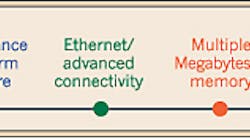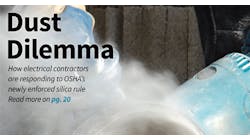Before purchasing a power quality meter, make sure its features actually meet your needs
A permanently installed, comprehensive metering system that is layered within a facility can provide real-time information that will allow you to respond more quickly to undesirable system performance. Because capital dollars are invariably limited, monitoring the electrical system can provide insights into where these funds can be best spent. It's a paradox that capital expenditures for a comprehensive monitoring system can minimize other potential capital expenditures to repair or replace damaged equipment.
Selecting a power quality meter.
With many choices on the market today, selecting the appropriate meter to handle your power quality considerations can be a daunting task. Fig. 1 illustrates the evolution of capabilities from many fixed electrical metering products. The complexity of meters has increased over time based on the needs — or in some cases the perceived needs — of the industry. The capabilities of the latest meters far exceed the standard from a few years ago.
The first step in choosing a meter is to determine your goal for the monitoring system. Meters that measure parameters like energy usage, peak demand, and basic voltage/current will be less sophisticated, yet less expensive and often easier to use, than a higher-end meter. But the increasing complexity of end-use equipment in today's commercial and industrial facilities may necessitate a more capable meter.
In most cases, a meter's cost determines its limitations because all metering devices are constrained by hardware, firmware, and software functionality. Hardware constraints include memory size, processor speed, precision, and accuracy of the discrete components. Metering firmware constraints include memory size and processor speed. Software constraints include memory size, processor speed, and operating platform. Other important constraints include available accessories like I/O functionality, communications device interfaces, ride-through capacity, and remote display capabilities.
Power quality meters should include basic features like the ability to capture, view, and provide alarms based on anomalies or steady-state conditions that can affect the operation of equipment or processes. Again, a meter must be able to examine several categories of power quality issues. A meter that provides comprehensive information on all power quality categories will be more useful in facilities that require higher levels of power quality. It stands to reason that such a meter will also be more expensive. If your concerns extend only to issues like voltage sags or harmonics, then you might be better served by using a meter of reduced capabilities.
Some meter manufacturers periodically provide new releases of meter firmware, which is programming code that's created and tested like software. You download the firmware into a meter's read-only memory (ROM), making it a permanent part of its capabilities. Once the meter manufacturer has developed and coded new features into the firmware, you can distribute and install the new firmware into the meter's programmable ROM using a special user interface. New firmware releases, typically provided free of charge by manufacturers, are sometimes used to correct errors in the metering algorithms. The ability to update a meter's firmware is an expensive method to enhance the existing feature set of your meter without purchasing new hardware.
In general, loads to be monitored in a comprehensive metering scheme are usually dispersed throughout a facility. Receiving timely information from all the metered loads requires that the meters interconnect with a central point of data aggregation via a communications network. The most available means to link the monitoring system are Ethernet, serial, or modem interconnections, all of which are commonly used. The communications protocol is a special set of rules that defines how devices communicate with each other. MODBUS protocol is the most popular and most widely accepted for today's metering systems.
The real potential of a good power quality monitoring system lies in its extensive link between the hardware and software. In a power monitoring system, the hardware collects and stores the data from the point of installation. Then, either a PC uploads the data or a meter “pushes” the data up to a PC for more specific processing and analysis. Because a PC has large amounts of storage and vast processing capabilities, you receive more insight into the condition of your electrical system through more post-processing. A permanently mounted metering scheme has additional strengths because it's typically layered through the electrical system. If the software has access to data from all these meters, you can more easily determine the characterization of the power quality throughout the facility.
A useful capability that isn't new is the ability to measure harmonic power flows, which indicate the direction of the power flow at different harmonic components. In Fig. 3 below, the fundamental component (60 Hz) flows in from the utility to the loads that consume it, as under normal circumstances. Because the utility typically has very low source impedance, the third harmonic component (180 Hz) flows out to the utility in this case. This feature provides a simple method of determining not only the source of a harmonic problem — upstream or downstream from the metering device — but can provide additional information about the source and location of the problem.
Configuring a meter to monitor for power quality events can be discouraging at times due to the confusion and complexity of where to set thresholds for the various power quality categories. Some available meters provide an automated means of determining where the alarm thresholds should be set, based on the context of the meter. An alarm set point learning feature allows the meter to “learn” its electrical environment and then set the alarm thresholds accordingly. Other derivatives of this feature don't use thresholds, but manage the storage of events and summary reports in memory. In such a case, the meter records all anomalies until the memory is full, at which point more significant events override lesser events.
The letter and spirit of a metering specification.
The ultimate benefit of a comprehensive power quality monitoring system is to help you quickly locate and solve problems. Meter specifications can be a useful tool to assist you in selecting the meter that serves your needs and solves your electrical problems. Because specifications indicate a meter's capabilities, they also imply its limitations. However, understanding meter specifications can be difficult.
When you put out a request for bid, you have a list of requirements or specifications that a meter has to meet before it can be considered applicable. Meter manufacturers examine the specifications to see if and to what extent their products comply. But a product that meets the “letter” of your specifications won't necessarily meet their “spirit.”
For example, if you've experienced insulation failures in equipment motors, you might want to monitor transient overvoltage events to determine whether transient overvoltages are affecting the electrical system. Most basic meters can monitor some transient overvoltages, such as sampling at 65µsec or 32.5 µsec, based on the definition given in IEEE 1159-1995 (Sidebar below). As the meter's sampling rate increases, the data more accurately describes the transient event. The better the description of a transient event, the easier it will be to quantify its severity, ascertain its source type, or even locate the source itself. Fig. 4 illustrates a transient overvoltage event of roughly 750V captured from a meter sampling at 512 samples per cycle (32.5 µsec). Fig. 5 below shows the same transient overvoltage event, captured from a meter sampling at 83,333 samples per cycle (200 nsec), being greater than 2,500V. It's apparent in this case that the meter with the slower sampling rate didn't accurately define the true magnitude of the transient overvoltage event. Again, your goal for using a monitoring system should be more than just meeting the criteria outlined in a meter specification. It should also help you locate and solve problems.
Evaluating power quality based on standards. A relatively new feature in power quality metering is the ability to evaluate how an electrical system meets power quality standards established by organizations like the IEEE or IEC, or other international standards. If portions of the standards are ambiguous, a manufacturer could take liberties in defining it without consulting the authors to determine its actual intent. The manufacturer could assert that its product meets some specified standard while avoiding potentially rigorous criteria that might necessitate a range of complex algorithms or even hardware modifications. The unfortunate result of such a tactic is that you may get metering systems that don't meet their intended objective to help locate and solve electrical problems.
The solution to this dilemma is to understand why a given requirement is included within a meter specification. While many meters can detect transient overvoltage events as defined by a standard, they don't necessarily provide enough information to locate and solve the problem. Only by learning about electrical meters and understanding which features are needed for a specific application can you determine if a given meter really provides the required capabilities.
Meters offering advanced power quality functionality are becoming more affordable. A comprehensive power quality metering system should be able to do more than just notify the user of anomalies. It should be able to quantify the extent, location, and source of a problem. While you can use specifications as a general tool for selecting metering systems, you should be able to understand why to require a specific feature and whether a given meter can actually fulfill that requirement. In the end, a metering system selected based on its intended environment will be the best and most cost effective solution to power quality issues.
Bickel is staff product specialist with the Power Management Organization of Square D/Schneider Electric, LaVergne, Tenn.
Sidebar: Power Quality Categories: IEEE Std. 1159 Definitions
Many types of power quality events can affect equipment operation that you need to monitor. IEEE Std. 1159-1995, IEEE Recommended Practice on Monitoring Electrical Power Quality, defines seven basic categories of power quality phenomena:
-
Transients
-
Short-duration variations
-
Long-duration variations
-
Voltage imbalance
-
Waveform distortion
-
Voltage fluctuations
-
Power frequency variation
Most of these primary categories are further expanded into subcategories that provide additional description/quantification, based on some combination of magnitude, duration, and spectral content. European standards are also gaining support in the North American market. These standards further differentiate the array of power quality issues that can occur on electrical systems. Most meters are capable of monitoring steady-state (continuous) power quality concerns, such as voltage imbalance, undervoltage, or overvoltage. However, other power quality categories, such as higher order harmonics, inter-harmonics, voltage fluctuations, and transient overvoltages, require a more sophisticated meter. To adequately represent and provide enough detailed information to troubleshoot some problems, the meter must have additional microprocessor resources and advanced data acquisition capabilities.



